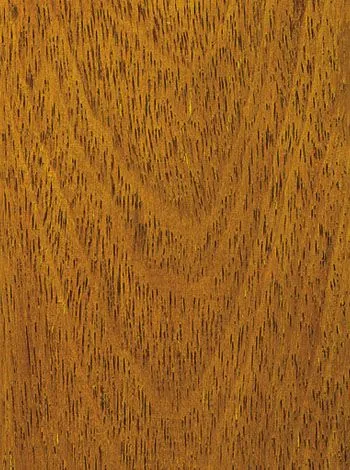| Introduction |
The Standard Malaysian Name for the timber of Intsia
spp., principally I. palembanica (Leguminosae). Vernacular names applied
include merbau ipil (Peninsular Malaysia) and ipil laut (Sabah) for I.
bijuga. Major species include I. bijuga and I. palembanica. The sapwood
is pale yellow to light buff and is sharply differentiated from the
heartwood, which is yellowish to orange-brown when fresh, darkening to
brown or dark red-brown on exposure. Also known as Kwila (Australia);
Merbau (Brunei); Krakasprek (Cambodia); Vesi (Fiji); Besi kesia, Ipil,
Kayu besi and Merbau (Indonesia); Tat-takun (Myanmar); Komu (New
Caledonia); Bendora and Kwila (Papua New Guinea); Ipil, Ipil laut and
Malaipil (Philippines); Ifilele (Samoa Islands); Lumpha, Lumphor thale,
Lum-por and Maka-mong (Thailand); and Gonuo (Vietnam). |
| Botanical Name |
Intsia bijuga (formerly Afzelia bijuga syn. Afzelia australis), I. palembanica. Family name: Leguminosae. |
| Natural Durability |
The timber of merbau is classified as durable under
exposed conditions. The classification is based on the standard
graveyard tests of untreated specimens of dimension 50 mm x 50 mm x 600
mm conducted at the Forest Research Institute Malaysia (FRIM). Two such
tests were conducted on the species I. palembanica. In the first series
of such tests, the average service life for 14 test specimens was 5.5
years (Foxworthy & Woolley, 1930). In the second test, the average
service life for 60 specimens was 6 years (Jackson, 1965). |
| Uses |
Merbau is a very attractive wood, with its growth ring
figure and deep colour. The timber is suitable for interior finishing,
panelling, mouldings, office fittings, flooring (heavy traffic),
superior joinery, cabinet-making, musical instruments, ornamental items
and carvings. The timber is widely used for the manufacture of
reproduction antique furniture and strip flooring in the country. It is
also suitable for heavy construction, power transmission poles, railway
sleepers, decking, columns (heavy duty), door and window frames and
sills, fender supports, staircase (apron lining, rough bracket,
baluster, balustrade, carriage, handrail, newel, riser, stringer, tread,
bullnose, round end and winder), heavy duty furniture, tool handles
(impact) and pallets (heavy permanent type). |
| Texture |
Texture is rather coarse but even, with interlocked grain. |
| Density |
The timber is a Heavy Hardwood with a density of 515-1,040 kg/m3 air dry. |
| Shrinkage |
Shrinkage values are particularly low. Radial shrinkage averaging 0.9% and tangential shrinkage averaging 1.6%. |
| Defect |
The logs are generally free from common defects.
However, it has been reported that the timber is highly susceptible to
powder-post beetle attacks (Menon, 1958). |



